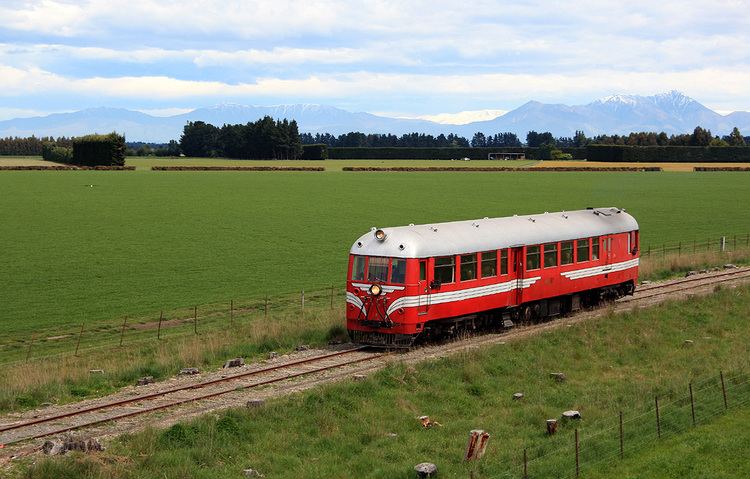Build date 1940–1942 UIC class A1A-2 | Serial number 4845–4854 Total produced 10 | |
 | ||
Power type Diesel-mechanical railcar | ||
The NZR RM class Vulcan railcars were operated by the New Zealand Government Railways (NZR) in the South Island of New Zealand. All New Zealand railcars were classified as RM (Rail Motor), and this class derived their nomenclature from the name of the manufacturer, the Vulcan Foundry of Britain.
Contents
Background
On 9 May 1938, the Minister of Railways announced an order for ten railcars from the Vulcan Foundry of Britain. They were intended to provide a service on the Midland Line from Christchurch to the West Coast, replacing the four-wheel Midland railcars built in 1936 for the service as a temporary measure.
The Vulcan railcars had a driver's compartment at each end, so they did not need to be turned at the terminus for the return journey. They originally had 28 and 22 seats in the two passenger compartments, but the second compartment was reduced to 20 seats, with a small guard's compartment replacing two seats and reducing the number of passengers from 50 to 48.
They had a low axle loading to operate on routes like the Stillwater - Westport Line with light bridges, hence the power bogie was built with three axles with an intermediate carrying axle instead of two axles as originally proposed. They were designed to operate at speeds of up to 120 km/h (75 mph), though in service they were restricted to a maximum speed of 90 km/h (56 mph), still fast for rural New Zealand railway lines at the time.
The first Vulcan railcar arrived in New Zealand in September 1940. Three more arrived by April 1941, with all nine members in operation by the second half of 1942. Ten railcars had been built, but only nine arrived in New Zealand as the ship carrying the tenth was sunk during World War II.
Speed record
On trials on 25 October 1940, RM 50 achieved a speed of 125.5 km/h (78 mph) on a section of the Midland Line east of Springfield. This remains the fastest speed officially attained on New Zealand's railway network, though unofficially, it has been claimed that JA class steam locomotives attained higher speeds on the "racetrack" section of the Main South Line near Rakaia.
Operation
Before all members of the class had arrived, the Vulcans and Leyland diesel railcars alternated services along the Midland Line and the Ross Branch to Hokitika, but by September 1942, the Vulcans had fully taken over the service and the Leylands were withdrawn and scrapped. From 7 September 1942, wartime petrol restrictions meant the Vulcans were put into service on the Stillwater - Westport Line, even though the line through the Buller Gorge technically wasn't finished and hadn't been handed over to the Railways Department from the Public Works Department. Also due to the petrol restrictions, a service between Christchurch and Timaru was instituted and the Hokitika run extended all the way to Ross. After the war ended, the Timaru run was cancelled, but the West Coast services continued to operate.
In 1955, the 88 seater railcars entered service in New Zealand, and on 20 February 1956, they began operating the services from Christchurch to Ross via Greymouth, significantly reducing the use of the Vulcans. Accordingly, some Vulcans were transferred to Dunedin and put to use on passenger services along the Otago Central Railway to Cromwell, commencing service on 1 October 1956. In April 1957, three derailments led to the postponement of the service while the line was upgraded, and the service did not resume until 10 November 1957. From 11 May 1958, the portion of the trip from Alexandra to Cromwell was cancelled due to low passenger numbers. Also that year, another use was found for the Vulcans, with a weekday morning service operated from Palmerston to Dunedin and a return service run in the evening. This commenced on 29 September 1958, and the railcars were also used for Dunedin suburban services---notably a midday service to Port Chalmers---whenever they were available for such use. Between 1967 and 1975 the Vulcans replaced the twinsets on the Christchurch- Picton railcar service, except during summer holidays when short trains were substituted.
The Vulcan railcars were never used in the North Island, where the Standard railcars performed a similar job.
Withdrawal and preservation
The age of the railcars and declining passenger numbers due to competition from road transport led to the decline in use of the Vulcans. The service between Westport and Greymouth ceased in 1967, but with the need to conserve the Twinsets for weekend services on the Christchurch- Greymouth route the Vulcans ran on all remaining South Island routes in 1975-76 even the long fast Invercargill-Christchurch run and were finally used on the West Coast service run until Sept 1978,when after almost three decades of heavy use in the rural South Island, they were all withdrawn from service .
Four of the nine were preserved, one by the The Plains Vintage Railway & Historical Museum (RM 50) and three by the Ferrymead Railway (RM 51, RM 56, RM 57). RM's 51 & 56 sees regular use.
